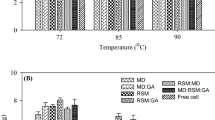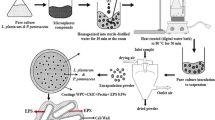Abstract
Food-grade cryoprotective agents, i.e., skim milk, soy powder, yeast extract, and trehalose were tested for viability of lactic acid bacteria (LAB, Lactobacillus brevis WK12 and Lactococcus lactis WK11) during freeze drying. Ten percentage of soy powder showed a strong protective effect upon viability of both LAB, showing 1.85×1011 CFU/mL for L. brevis WK12 and 1.89×1011 CFU/mL for L. lactis WK11. Microencapsulation in Ca-alginate beads increased viability of LAB, compared to nonencapsulated cells. Moreover, there was a synergetic effect on the stability of LAB when encapsulated LAB in Ca-alginate beads were soaked in 10% of soy powder prior to freeze-drying. When temperature increased, however, survival of LAB decreased. Four weeks after storage the highest viability was observed at -18°C for L. brevis WK12 and L. lactis WK11, showing 1.80×1011 CFU/mL and 1.78×1011 CFU/mL, respectively. These results suggest that soy powder may be useful for enhancing viability of LAB with microencapsulation.
Similar content being viewed by others
References
Jeong SH, Lee HJ, Jung JY, Lee SH, Seo HY, Park WS, Jeon CO. Effects of red pepper powder on microbial communities and metabolites during kimchi fermentation. Int. J. Food Microbiol. 160: 252–259 (2013)
Ko JA, Kim WY, Park HJ. Effects of microencapsulated allyl isothiocyanate (AITC) on the extension of the shelf-life of kimchi. Int. J. Food Microbiol. 153: 92–98 (2012)
Lee KW, Park JY, Chun J, Han NS, Kim JH. Importance of Weissella species during kimchi fermentation and future works. Microbiol. Biotechnol. Lett. 38: 341–348 (2010)
Kim J, Bang J, Beuchat LR, Kim H, Ryu J-H. Controlled fermentation of kimchi using naturally occurring antimicrobial agents. Food Microbiol. 32: 20–31 (2012)
Lee J-Y, Kim C-J, Kunz B. Identification of lactic acid bacteria isolated from kimchi and studies on their suitability for application as starter culture in the production of fermented sausages. Meat Sci. 72: 437–445 (2006)
Leslie SB., Israeli E, Lighthart B, Crowe JH, Crowe LM. Trehalose and sucrose protect both membranes and proteins in intact bacteria during drying. Appl. Environ. Microb. 61: 3592–3597 (1995)
Abadias M, Benabarre A, Teixidó N, Usall J, Viñas I. Effect of freezedrying and protectants on viability of the biocontrol yeast Candida sake. Int. J. Food Microbiol. 65: 173–182 (2001)
Wisselink HW, Weusthuis RA, Eggink G, Hugenholtz J, Grobben GJ. Mannitol production by lactic acid bacteria: A review. Int. Dairy J. 12: 151–161 (2002)
Hubalek Z. Protectants used in the cryopreservation of microorganisms. Cryobiology 46: 205–229 (2003)
Carvalho AS, Silva J, Ho P, Teixeira P, Malcata FX, Gibbs P. Protective effect of sorbitol and monosodium glutamate during storage of freeze-dried lactic acid bacteria. Dairy Sci. Technol. 83: 203–210 (2003)
Costa E, Usall J, Teixidó N, Garcia N, Viñas I. Effect of protective agents, rehydration media and initial cell concentration on viability of Pantoea agglomerans strain CPA-2 subjected to freeze-drying. J. Appl. Microbiol. 89: 793–800 (2000)
Jankowski T, Zielinska M, Wysakowska A. Encapsulation of lactic acid bacteria with alginate/starch capsules. Biotechnol. Tech. 11: 31–34 (1997)
Ramakrishna SV, Prakasham RS. Microb ial fermentations w ith immob ilized cells. Curr. Sci. India 77: 87–100 (1999)
Giulio B, Orlando P, Barba G, Coppola R, Rosa M, Sada A, Prisco PP, Nazzaro F. Use of alginate and cryo-protective sugars to improve the viability of lactic acid bacteria after freezing and freeze-drying. World J. Microb. Biot. 21: 739–746 (2005)
Santagapita PR, Mazzobre MF, Buera MP. Invertase stability in alginate beads: Effect of trehalose and chitosan inclusion and of drying methods. Food Res. Int. 47: 321–330 (2012)
Bang KH, Kim KJ, Oh DH, Rhee YH. High-density cultivation and cryopreservation of Saccharomyces cerevisiae Hansen CBS5926. Microbiol. Biotechnol. Lett. 35: 302–306 (1999)
Sheu TY, Marshall RT. Microentrapment of lactobacilli in calcium alginate gels. J. Food Sci. 58: 557–561 (1993)
Gaudio PD, Colombo P, Colombo G, Russo P, Sonvico F. Mechanisms of formation and disintegration of alginate beads obtained by prilling. Int. J. Pharm. 302: 1–9 (2005)
Jalali M, Abedi D, Varshosaz J, Najjarzadeh M, Mirlohi M, Tavakoli N. Stability evaluation of freeze-dried Lactobacillus paracasei s ub sp. tolerance and Lactobacillus delbrueckii subsp. bulgaricus in oral capsules. Res. Pharm. Sci. 7: 31–36 (2012)
Das NK, Kilara A, Shahani KM. Effect of cryoprotectant on freeze-drying and storage of lactic cultures. Cult. Dairy Prod. J. 11: 8–11 (1976)
Kets EPW, Teunissen PJM, de Bont JAM. Effect of compatible solutes on survival of lactic acid bacteria subjected to drying. Appl. Environ. Microb. 62: 259–261 (1996)
Kearney L, Upton M, Loughlin A. Enhancing the viability of Lactobacillus plantaruminoculum by immobilizing the cells in calcium-alginate beads incorporating cryoprotectants. Appl. Environ. Microb. 56: 3112–3116 (1990)
Castro HP, Teixeira PM, Kirby R. Storage of lyophilized cultures of Lactobacillus bulgaricus under different relative humidities and atmospheres. Appl. Microbiol. Biot. 44: 172–176 (1995)
Valdez GF, Giori GS, Ruiz Holgado AP, Oliver G. Protective effect of adonitol on lactic acid bacteria subjected to freeze-drying. Appl. Environ. Microb. 45: 302–304 (1983)
Lin TM, Durance TD, Scaman CH. Characterization of vacuum microwave, air and freeze-dried carrot slices. Food Res. Int. 31: 111–117 (1998)
Otero MC, Espeche MC, Nader-Macías ME. Optimization of the freeze-drying media and survival throughout storage of freeze-dried Lactobacillus gasseri and Lactobacillus delbrueckii sub sp. delbrueckii for veterinarian probiotic applications. Process Biochem. 42: 1406–1411 (2007)
Zayed G, Roos YH. Influence of trehalose and moisture content on survival of Lactobacillus salivarius subjected to freeze-drying and storage. Process Biochem. 39: 1081–1086 (2004)
Savini M, Cecchini C, Verdenelli MC, Silvi S, Orpianesi C, Cresci A. Pilot-scale production and viability analysis of freeze-dried probiotic bacteria using different protective agents. Nutrients 2: 330–339 (2010)
Seo MJ, Lee JY, Nam YD, Lee SY, Park SL, Yi SH, Lee MH, Roh SW, Choi HJ, Lim SI. Production of γ-aminobutyric acid by Lactobacillus brevis 340G isolated from kimchi and its application to skim milk. Food Eng. Prog. 17: 418–423 (2013)
Chávarri M, Marañón I, Ares R, Ibáñez FC, Marzo F, Villarán M. Microencapsulation of a probiotic and prebiotic in alginate-chitosan capsules improves survival in simulated gastro-intestinal conditions. Int. J. Food Microbiol. 142: 185–189 (2010)
Krasaekoopt W, Bhandari B, Deeth H. Evaluation of encapsulation techniques of probiotics for yoghurt. Int. Dairy J. 13: 3–13 (2003)
Heckly RJ. Preservation of bacteria by lyophilization. Adv. Appl. Microbiol. 3: 1–76 (1961)
Mitic S, Otenhajmer I. Predicting the stabilities of freeze-dried suspensions of Lactobacillus acidophilus by the accelerated storage test. Cryobiology 11: 116–120 (1974)
Giraffa G. Enterococci from foods. FEMS Microbiol. Rev. 26: 163–171 (2002)
Fonseca F, Béal C, Corrieu G. Method of quantifying the loss of acidification activity of lactic acid starters during freezing and frozen storage. J. Dairy Res. 67: 83–90 (2000)
Author information
Authors and Affiliations
Corresponding author
Rights and permissions
About this article
Cite this article
Gwak, H.J., Lee, JH., Kim, TW. et al. Protective effect of soy powder and microencapsulation on freeze-dried Lactobacillus brevis WK12 and Lactococcus lactis WK11 during storage. Food Sci Biotechnol 24, 2155–2160 (2015). https://doi.org/10.1007/s10068-015-0287-5
Received:
Revised:
Accepted:
Published:
Issue Date:
DOI: https://doi.org/10.1007/s10068-015-0287-5




